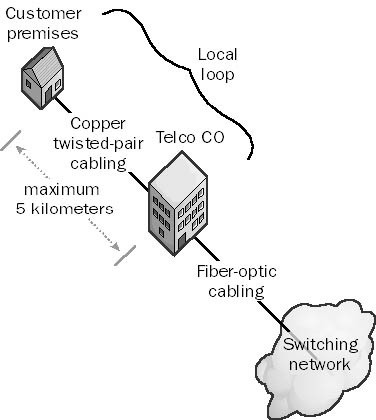The local loop, often termed the “last mile” or “final mile,” is more than just a stretch of wires connecting homes and offices to the telecommunications world. It’s the lifeline of communication, a foundational element in the vast web of telecommunication. This article delves deep into understanding its significance, evolution, and current relevance in our constantly evolving digital era.
In this article:
- What is a Local Loop?
- Historical Context of the Local Loop
- The Core Function of the Local Loop
- The Technological Landscape Then and Now
- Adapting to New Technologies and Standards
- Challenges and the Path Forward
- Conclusion
- References & Video
1. What is a Local Loop?
Local Loop is the portion of the telephone system that connects your home or office to the nearest central office (CO) of your local telco.
The wiring used in the local loop is usually unshielded twisted-pair (UTP) cabling, the transmission method is analog transmission, and the maximum distance from the telco’s CO to the subscriber’s customer premises is about 5 kilometers.

2. Historical Context of the Local Loop
The foundation of telecommunication is built on connections, and for the longest time, the local loop provided this connection, acting as the bridge between individual premises and the broader telephone network.
In the early days, when the Plain Old Telephone Service (POTS) reigned supreme, the local loop was a simple copper line. This analog system relayed voice via electrical signals. As the need for internet access grew, dial-up lines became a household necessity. Here, the modem at the user’s end would communicate with the modem at the central office of the telco. This handshake, facilitated by the local loop, was the precursor to the world of online connectivity we now know.
3. The Core Function of the Local Loop
The primary role of the local loop has always been to provide a direct, physical connection between the user’s premises and the nearest telco’s central office. Through this connection, voice and data signals are transmitted, making services like voice calls, faxes, and eventually, internet access possible.
However, it’s not just about physical connectivity. The local loop plays a pivotal role in signal modulation and demodulation. When you used a dial-up connection, for instance, the modems at both ends relied on the local loop to modulate (send) and demodulate (receive) signals. This functionality, although taken for granted, was revolutionary, setting the stage for the digital age.
4. The Technological Landscape Then and Now
While copper wires dominated the local loop landscape for many decades, the relentless march of technology ensured the loop’s evolution. The first significant shift was from analog to digital, which provided clearer voice communication and paved the way for DSL (Digital Subscriber Line) services, offering faster internet speeds.
Fiber optics marked the next big leap. With the ability to transmit data as light signals, fiber-optic lines boasted significantly higher bandwidths and lower latency compared to traditional copper lines. This transformation was especially vital in urban areas where the demand for high-speed internet, VoIP, and streaming services surged. With fiber, data could travel longer distances without much degradation, making it the medium of choice for modern local loops.
Furthermore, the development of technologies such as FTTH (Fiber-To-The-Home) and FTTB (Fiber-To-The-Building) further emphasized the shift to fiber optics, ensuring that individual homes and offices could directly benefit from the superior capabilities of fiber.
5. Adapting to New Technologies and Standards
In the dynamic world of telecommunications, the local loop has continually evolved to meet both user demands and the ever-changing technical landscape. Beyond the transition from copper to fiber optics, the local loop’s adaptability is evident in its embrace of new protocols and standards.
With the rise of broadband, DSL technologies utilized the existing copper infrastructure of the local loop to provide faster internet connectivity. This adaptation, while resourceful, was only a stepping stone. Today’s local loop is increasingly integrating with technologies such as G.fast, which amplifies the data-carrying capabilities of existing infrastructure.
Furthermore, with the rollout of 5G, the convergence of fixed-line and wireless connectivity is now in focus. The local loop is pivotal in this fusion, aiding in the creation of hybrid networks that leverage the strengths of both wired and wireless technologies. Standards like NG-PON2 (Next-Generation Passive Optical Network 2) are setting the pace, offering multi-gigabit speeds over the local loop.
6. Challenges and the Path Forward
While the local loop’s journey has been impressive, it’s not without challenges. As urban areas enjoy the benefits of high-speed fiber connectivity, many rural regions grapple with dated infrastructure. Bridging this digital divide remains a top priority.
Additionally, the local loop faces hurdles in integrating with emerging technologies. The proliferation of IoT devices, for instance, demands ultra-reliable low-latency communication (URLLC). Ensuring the local loop can provide such capabilities while handling increased data traffic requires continuous innovation.
The path forward is a blend of modernization and inclusivity. Infrastructure upgrades are essential, but so is ensuring that every user, regardless of their location, benefits from the advancements in the local loop. Collaborative efforts between policymakers, service providers, and tech innovators are the key to a future-ready local loop.
7. Conclusion
The local loop, often termed the unsung hero of telecommunications, remains as relevant today as it was in the era of POTS. While its form and function have evolved, its essence as the vital link connecting users to the wider world remains unchanged. As we stand on the brink of new technological frontiers, the local loop’s journey of adaptation and growth serves as a testament to the resilience and innovation inherent in our communication networks. As history has shown, no matter the challenge or change, the local loop adapts, ensuring we remain connected today, tomorrow, and beyond.